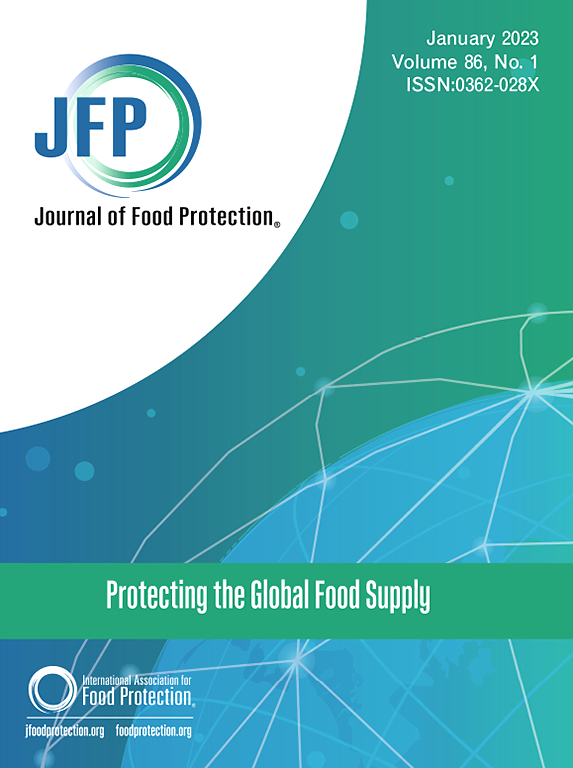Predictive Models of Consumer Flour-Handling Behaviors and Recall Awareness
IF 2.1
4区 农林科学
Q3 BIOTECHNOLOGY & APPLIED MICROBIOLOGY
引用次数: 0
Abstract
In recent years, many recalls have been linked to flour and flour-based products. However, many consumers remain unaware of these recalls and continue to perform risky flour-handling behaviors. Food recalls are an essential tool for manufacturers, distributors, and government agencies to inform consumers about foods that may cause health issues, which has the potential to change consumers’ food safety behaviors. In this study, researchers constructed model-ensembles to predict and identify the top predicting factors for consumers’ flour recall awareness and their safe flour-handling behaviors. Researchers also tested the impact of the volume of flour recalls within a consumer’s state of residence on their recall awareness and flour-handling behaviors. Findings indicate that consumers who perceive a higher likelihood of flour recall, aged between 18 and 24, and who pay attention to the lot number, are more likely to be aware of flour recalls. Consumers who perceive the risks of eating raw dough or batter, believe raw chicken poses a microbial risk, and are younger, are more likely to have an increased flour-handling behavior score. However, the volume of recalls in a consumer’s state of residence was found to have a low predictive ability for consumers’ flour recall awareness and safe flour-handling behaviors. This is the first study utilizing predictive modeling to investigate the critical factors affecting consumers’ flour recall awareness and handling behaviors. The findings emphasize the importance of risk perceptions in shaping consumers’ behaviors and provide implications for policymakers, food safety experts, and educators in tailoring communication strategies to enhance consumers’ risk perceptions and thereby reduce their likelihood of contracting foodborne illnesses due to improper flour-handling behaviors.
消费者面粉处理行为与召回意识的预测模型。
近年来,许多召回都与面粉和面粉制品有关。然而,许多消费者仍然不知道这些召回,并继续进行危险的面粉处理行为。食品召回是制造商、分销商和政府机构告知消费者可能导致健康问题的食品的重要工具,这有可能改变消费者的食品安全行为。在本研究中,研究者构建模型集合来预测和识别消费者的面粉召回意识及其安全面粉处理行为的最重要预测因素。研究人员还测试了消费者居住州内的面粉召回量对他们的召回意识和面粉处理行为的影响。调查结果表明,年龄在18至24岁之间的消费者认为面粉召回的可能性更高,并且注意批号的消费者更有可能意识到面粉的召回。那些意识到吃生面团或面糊有风险、认为生鸡肉有微生物风险、年龄较小的消费者,更有可能在处理面粉的行为上得分更高。然而,消费者居住州的召回量对消费者的面粉召回意识和安全面粉处理行为的预测能力较低。本研究首次运用预测模型探讨影响消费者面粉召回意识及处理行为的关键因素。研究结果强调了风险认知在塑造消费者行为方面的重要性,并为政策制定者、食品安全专家和教育工作者提供了建议,以调整沟通策略,提高消费者的风险认知,从而减少他们因不当的面粉处理行为而感染食源性疾病的可能性。
本文章由计算机程序翻译,如有差异,请以英文原文为准。
求助全文
约1分钟内获得全文
求助全文
来源期刊

Journal of food protection
工程技术-生物工程与应用微生物
CiteScore
4.20
自引率
5.00%
发文量
296
审稿时长
2.5 months
期刊介绍:
The Journal of Food Protection® (JFP) is an international, monthly scientific journal in the English language published by the International Association for Food Protection (IAFP). JFP publishes research and review articles on all aspects of food protection and safety. Major emphases of JFP are placed on studies dealing with:
Tracking, detecting (including traditional, molecular, and real-time), inactivating, and controlling food-related hazards, including microorganisms (including antibiotic resistance), microbial (mycotoxins, seafood toxins) and non-microbial toxins (heavy metals, pesticides, veterinary drug residues, migrants from food packaging, and processing contaminants), allergens and pests (insects, rodents) in human food, pet food and animal feed throughout the food chain;
Microbiological food quality and traditional/novel methods to assay microbiological food quality;
Prevention of food-related hazards and food spoilage through food preservatives and thermal/non-thermal processes, including process validation;
Food fermentations and food-related probiotics;
Safe food handling practices during pre-harvest, harvest, post-harvest, distribution and consumption, including food safety education for retailers, foodservice, and consumers;
Risk assessments for food-related hazards;
Economic impact of food-related hazards, foodborne illness, food loss, food spoilage, and adulterated foods;
Food fraud, food authentication, food defense, and foodborne disease outbreak investigations.
 求助内容:
求助内容: 应助结果提醒方式:
应助结果提醒方式:


